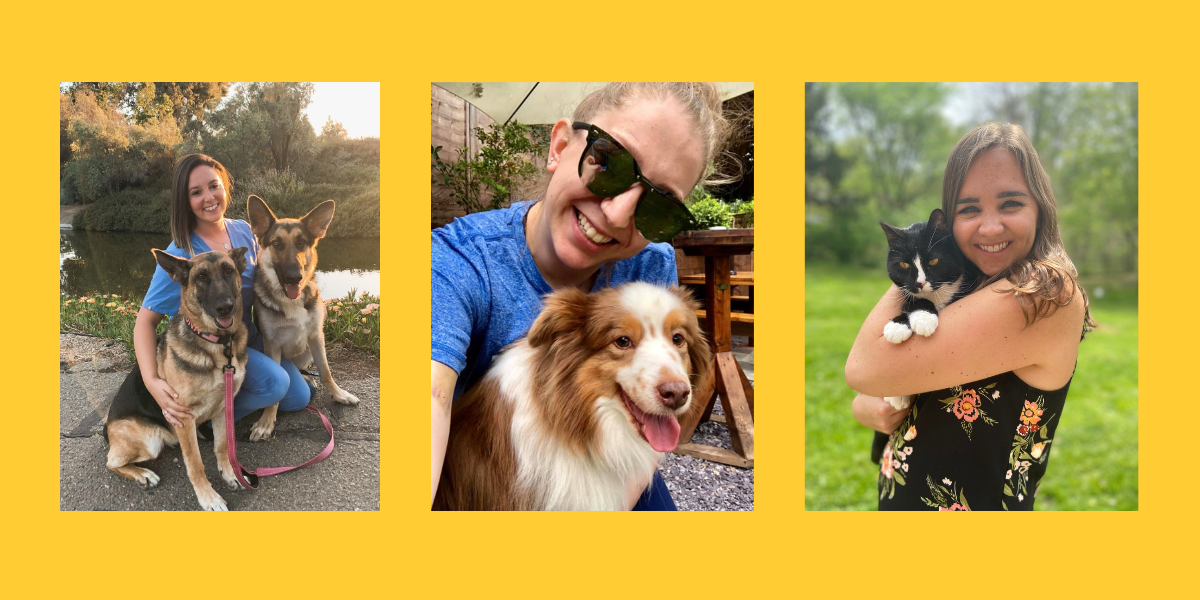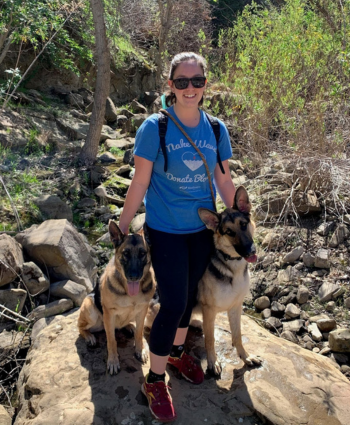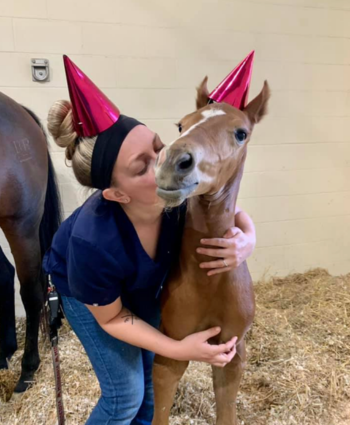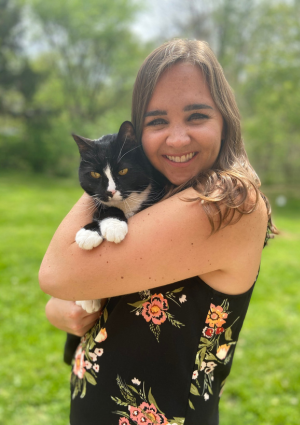Meet the chief residents
Three outstanding residents have been selected by CVM instructors to serve in key leadership positions

Three outstanding residents have been selected by CVM instructors to serve in key leadership positions
(Left to right) Drs. Marisa Ciccozi, Zoe Inglis, and Annalisa Judy were named chief residents at the College of Veterinary Medicine's Veterinary Medical Center.
Chief residents serve an important role within the College of Veterinary Medicine's veterinary hospitals. It's a job that comes with administrative duties, such as scheduling labs and on-call staff, but also offers a platform for residents to work with staff, students, and faculty in pursuit of improving patient care and increasing efficiency.
Meet this year's equine/large animal and small animal residents.
Dr. Marisa Ciccozi’s passion for animals runs deep and has driven a desire to become a veterinarian since she was young.
“I have a drawing from kindergarten where I drew animals and a stethoscope and said I wanted to be a vet,” she says.

Ciccozi had initially planned to specialize in large animal medicine but fell in love with cardiology and shifted to small animals. Now a second-year cardiology resident at the College of Veterinary Medicine, Ciccozi was recently named to an important role. She is one of two chief residents who lead the small animal residents and interns, also known as house officers.
As Ciccozi settles into the role of chief resident, she thinks her approachability and willingness to listen will be helpful. The year she’ll spend as chief resident, she expects, will strengthen her communication and organizational skills.
She looks forward to advocating for her fellow residents and expects coordinating different departmental goals within the hospital will be one of the biggest challenges. Ciccozzi knows that changes don’t happen overnight and that she must be patient.
“I have been surprised by the extent of coordination that needs to occur to express concerns and initiate change,” Ciccozzi says when reflecting on her residency.
To amplify the voice of her peers, she wants to empower house officers to advocate for themselves directly by coordinating with the house officer advocacy committee.
Before starting her residency program, Ciccozzi obtained her undergraduate degree and her doctorate of veterinary medicine at the University of California–Davis, followed by completion of a small animal rotating internship at the University of Minnesota. As a second-year resident, Ciccozi expects to complete her training in July 2025. When finished, she plans to stay in academia and work as a faculty member in cardiology.
When Ciccozi finds free time, she enjoys hanging out with her dogs and fiancé and hiking or visiting a new brewery. The dogs, both German shepherds, are an 8-year-old female named Luna and a 4-year-old male named Odin. They have a sibling, a senior feline named Sir William the 3rd (a.k.a. Billy).
Striking a good work-life balance while in veterinary medicine can be a challenge. Add extra leadership responsibilities to an already busy schedule, and maintaining that balance becomes even more elusive. Dr. Zoe Inglis, recently named chief resident of equine and large animal medicine, recognizes extra meetings and extra responsibilities—big and small—as part of the role and an investment in her future.

Serving as the chief resident, Inglis hopes, will increase her understanding of the non-medicine side of the profession. She expects to leave the role better equipped to take leadership roles in her career and, possibly, her own practice one day.
Passionate about horses, Inglis has worked with them her entire life. Her sights initially set on becoming an equine veterinarian, Inglis discovered a love of food animal medicine in veterinary school. She didn’t initially anticipate finding a way to combine her love for advanced medicine with food animals and horses but the College of Veterinary Medicine (CVM) has provided her the opportunity.
“Finding a residency that allows me to train to practice advanced medicine with horses and other large animals has been such a blessing, and it’s been so much fun,” she says.
English-born and California-raised, Inglis obtained her undergraduate degree and an accelerated MBA in her home state at California Polytechnic State University, San Luis Obispo. Heading across the pond, she completed her veterinary degree at the Royal Veterinary College in London. After completing a one-year medicine-focused internship at CVM, Inglis started her residency in July 2021 and now serves as chief resident until July 2024.
As a chief resident, Inglis serves as a leader and an advocate for the large animal specialty, ensuring that the group is represented in decision-making within CVM hospitals.
As she navigates the chief resident role, guidance from two residents who previously served as chief has proven invaluable for Inglis. When she has questions about her new responsibilities, they provide informed advice.
“They both did an incredible job and are excellent at hyping me up and reminding me what I can do to best represent my colleagues,” Inglis says. “When I want to whine about something, they’ve been in my shoes and can make me laugh and remember that it’s not really that bad.”
Inglis is still considering her career options following the final year of residency. While she loves working with students and would be happy to stay in academia because of the exciting cases they review, she would also be glad to enter private practice and have a more routine client base. She acknowledges that time in the role of chief resident in the year ahead may influence the next steps.
When she has a spare moment, Inglis enjoys time spent wrangling her dogs and riding horses. Her husband is big into the outdoors, so they also hope for good weather and more time to camp and hike with the dogs. Their pets include a 13-year-old miniature Aussie shepherd named Rue, a 9-year-old domestic shorthair named Moose, a 3-year-old American pitbull terrier named Mya, and Jax, a 2-year-old Belgian malinois.
Dr. Annalisa Judy has an extra-busy year ahead. In addition to the traditional responsibilities of a third-year veterinary resident at the College of Veterinary Medicine (CVM), she will assume the extra duties after being named a small animal chief resident.
Growing up, Judy always wanted to become a veterinarian and was planning to focus on equine medicine.
“I never saw myself doing anything else,” she says. “I wanted to do this since I was 5 years old.”

While initially planning to become an equine veterinarian, she shifted her focus from equine medicine to small animal medicine. Working as part of a team in a hospital setting appealed to her more than long solo hours of ambulatory medicine for horses. She also realized that she wanted a horse as a hobby more than as the focus of her veterinary career.
Earning an undergraduate degree from Colorado State University and a DVM from Ohio State University, Judy also interned at the CVM before starting her residency in July 2021. The challenge of diagnosing and treating various conditions draws Judy to veterinary medicine. Her ability to do it well secured the trust of her mentors when it came time to select chief residents.
Residents in small animal critical care advance their clinical skills working in the emergency room and with cats or dogs in the intensive care unit. Spending long hours in the Veterinary Medical Center caring for patients and communicating with pet owners, the residents simultaneously teach the fourth-year veterinary students and interns who shadow them throughout the day. On top of their clinical responsibilities, third-year residents must also prepare for board tests. As chief resident, Judy will add leadership tasks to that long list of responsibilities. She attends many administrative meetings with leadership, representing her fellow house officers and acting as their liaison.
Judy looks to gain leadership and communication skills in return for the extra responsibilities assumed as chief resident. One of her goals as chief includes speaking out to the administration on behalf of fellow residents. She knows the critical next step is the follow-up effort to find a solution acceptable to both sides.
By the time Judy completes her residency in July 2024, she expects the extra responsibilities assumed as chief resident will have increased her confidence in making big decisions and have further refined her teaching skills and ability to work through complex, critically ill patients. In the meantime, when she needs advice, Judy knows she has mentors in the chief residents who preceded her and taught her as an intern.
When her stint as chief resident is complete, Judy hopes to enter private practice as a critical medicine specialist. Ideally, she wants to land in a large hospital with interns to continue clinical teaching. If that hospital is in southern California and Judy never has to go through winter again, she says there would be no complaints. Eventually, she would consider returning to academia to teach the next generation of veterinarians.
When Judy has downtime, she spends it with her 14-year-old cat, Sky. Though she reports Sky is both naughty and nice, they have been together since her second year of veterinary school. Judy also enjoys camping, hiking, and playing guitar. She hopes to spend time camping and hiking in the national parks someday.